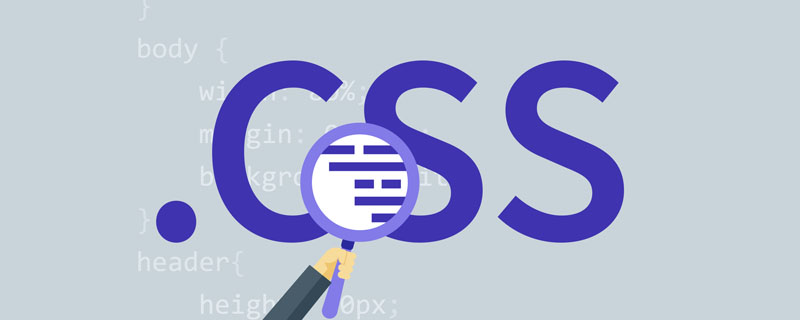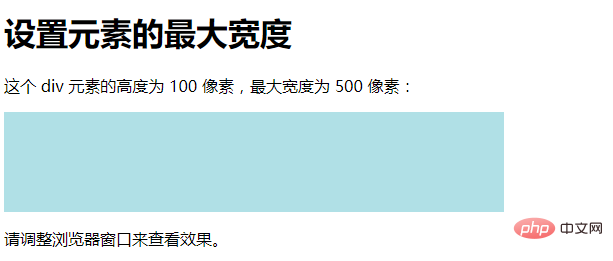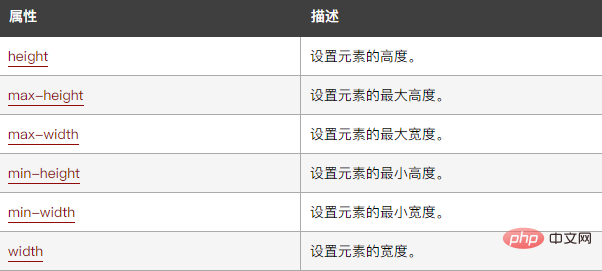Detailed explanation of CSS width and height properties
This article brings you relevant knowledge about css, which mainly introduces related issues about setting the height and width attributes of elements. The height and width attributes are used to set the height and width of elements. , the height and width properties do not include padding, borders, or margins. Let’s take a look at it together, I hope it will be helpful to everyone. .

(Learning video sharing: css video tutorial, html video tutorial)
CSS setting height and width
The height and width properties are used to set the height and width of the element.
The height and width properties do not include padding, borders, or margins. It sets the height or width of the area within the element's padding, border, and margins.
CSS height and width values
##height and width The property can be set to the following values:
auto
- Default. The browser calculates the height and width.#length
- Define height/width in px, cm, etc.%
- Defines the height/width as a percentage of the containing block.#initial
- Set height/width to default values.inherit
- Inherit height/width from its parent value.
Set the height and width of the
<!DOCTYPE html>
<html>
<head>
<style>
div {
height: 200px;
width: 50%;
background-color: powderblue;
}
</style>
</head>
<body>
<h1 id="设置元素的高度和宽度">设置元素的高度和宽度</h1>
<p>这个 div 元素的高度为 200 像素,宽度为 50%:</p>
<div></div>
</body>
</html>Output result:
 Remember, the height and width properties do not include padding, borders, or margins! They set the height/width of the area within the element's padding, borders, and margins!
Remember, the height and width properties do not include padding, borders, or margins! They set the height/width of the area within the element's padding, borders, and margins!
The max-width attribute is used to set the maximum width of an element.
max-width (maximum width) can be specified as a length value (e.g. px, cm, etc.) or as a percentage (%) of the containing block, or it can be set to none (the default. Meaning there is no maximum width).
When the browser window is smaller than the width of the element (500px), the previous
In this case, using max-width can improve the browser's handling of small windows.
Tip: Drag the browser window to less than 500px width to see the difference between the two divs!
Note: The value of the max-width attribute will override width.
The example is as follows:
<!DOCTYPE html>
<html>
<head>
<style>
div {
max-width: 500px;
height: 100px;
background-color: powderblue;
}
</style>
</head>
<body>
<h1 id="设置元素的最大宽度">设置元素的最大宽度</h1>
<p>这个 div 元素的高度为 100 像素,最大宽度为 500 像素:</p>
<div></div>
<p>请调整浏览器窗口来查看效果。</p>
</body>
</html>Output result:
 ##css size attribute:
##css size attribute:
(Learning video sharing:  css video tutorial
css video tutorial
html video tutorial)
The above is the detailed content of Detailed explanation of CSS width and height properties. For more information, please follow other related articles on the PHP Chinese website!

Hot AI Tools

Undresser.AI Undress
AI-powered app for creating realistic nude photos

AI Clothes Remover
Online AI tool for removing clothes from photos.

Undress AI Tool
Undress images for free

Clothoff.io
AI clothes remover

Video Face Swap
Swap faces in any video effortlessly with our completely free AI face swap tool!

Hot Article

Hot Tools

Notepad++7.3.1
Easy-to-use and free code editor

SublimeText3 Chinese version
Chinese version, very easy to use

Zend Studio 13.0.1
Powerful PHP integrated development environment

Dreamweaver CS6
Visual web development tools

SublimeText3 Mac version
God-level code editing software (SublimeText3)

Hot Topics
 1387
1387
 52
52
 How to use bootstrap in vue
Apr 07, 2025 pm 11:33 PM
How to use bootstrap in vue
Apr 07, 2025 pm 11:33 PM
Using Bootstrap in Vue.js is divided into five steps: Install Bootstrap. Import Bootstrap in main.js. Use the Bootstrap component directly in the template. Optional: Custom style. Optional: Use plug-ins.
 The Roles of HTML, CSS, and JavaScript: Core Responsibilities
Apr 08, 2025 pm 07:05 PM
The Roles of HTML, CSS, and JavaScript: Core Responsibilities
Apr 08, 2025 pm 07:05 PM
HTML defines the web structure, CSS is responsible for style and layout, and JavaScript gives dynamic interaction. The three perform their duties in web development and jointly build a colorful website.
 How to write split lines on bootstrap
Apr 07, 2025 pm 03:12 PM
How to write split lines on bootstrap
Apr 07, 2025 pm 03:12 PM
There are two ways to create a Bootstrap split line: using the tag, which creates a horizontal split line. Use the CSS border property to create custom style split lines.
 Understanding HTML, CSS, and JavaScript: A Beginner's Guide
Apr 12, 2025 am 12:02 AM
Understanding HTML, CSS, and JavaScript: A Beginner's Guide
Apr 12, 2025 am 12:02 AM
WebdevelopmentreliesonHTML,CSS,andJavaScript:1)HTMLstructurescontent,2)CSSstylesit,and3)JavaScriptaddsinteractivity,formingthebasisofmodernwebexperiences.
 How to resize bootstrap
Apr 07, 2025 pm 03:18 PM
How to resize bootstrap
Apr 07, 2025 pm 03:18 PM
To adjust the size of elements in Bootstrap, you can use the dimension class, which includes: adjusting width: .col-, .w-, .mw-adjust height: .h-, .min-h-, .max-h-
 How to use bootstrap button
Apr 07, 2025 pm 03:09 PM
How to use bootstrap button
Apr 07, 2025 pm 03:09 PM
How to use the Bootstrap button? Introduce Bootstrap CSS to create button elements and add Bootstrap button class to add button text
 How to set up the framework for bootstrap
Apr 07, 2025 pm 03:27 PM
How to set up the framework for bootstrap
Apr 07, 2025 pm 03:27 PM
To set up the Bootstrap framework, you need to follow these steps: 1. Reference the Bootstrap file via CDN; 2. Download and host the file on your own server; 3. Include the Bootstrap file in HTML; 4. Compile Sass/Less as needed; 5. Import a custom file (optional). Once setup is complete, you can use Bootstrap's grid systems, components, and styles to create responsive websites and applications.
 How to insert pictures on bootstrap
Apr 07, 2025 pm 03:30 PM
How to insert pictures on bootstrap
Apr 07, 2025 pm 03:30 PM
There are several ways to insert images in Bootstrap: insert images directly, using the HTML img tag. With the Bootstrap image component, you can provide responsive images and more styles. Set the image size, use the img-fluid class to make the image adaptable. Set the border, using the img-bordered class. Set the rounded corners and use the img-rounded class. Set the shadow, use the shadow class. Resize and position the image, using CSS style. Using the background image, use the background-image CSS property.




